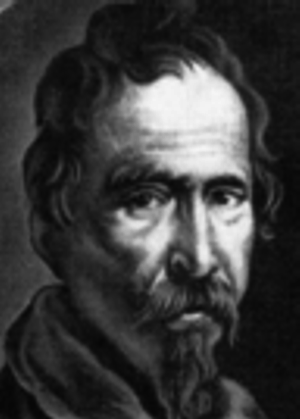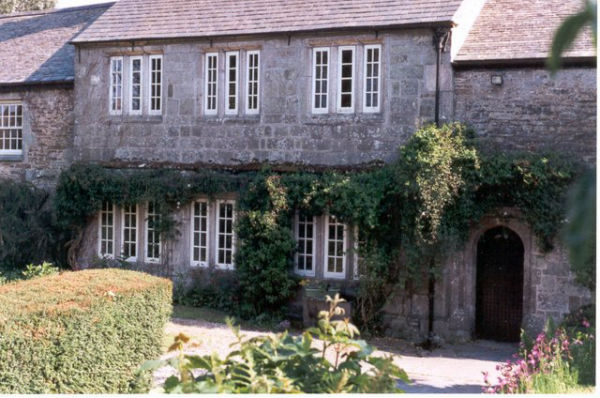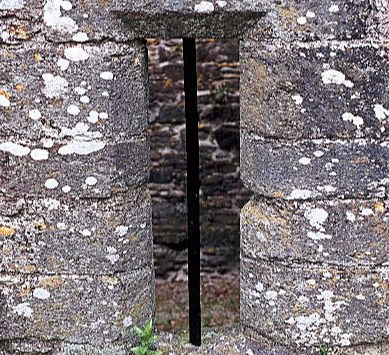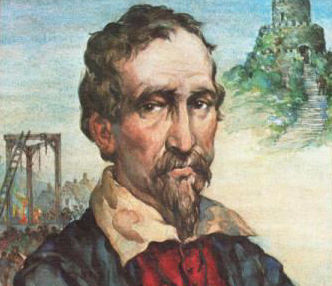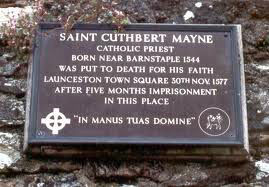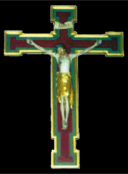Elizabeth I's agents quickly became aware of Cuthbert Mayne's presence in the area, and the authorities began a systematic search for him in June 1576, when the Bishop of Exeter William Broadbridge came to the area. High sheriff Sir Richard Grenville, a noted anti-Catholic officer, conducted a raid on Tregian's house on 8th June 1577, during which the crown officers "bounced and beat at the door" to Cuthbert Mayne's chamber.
On gaining entry, Grenville discovered a Catholic devotional article, an Agnus Dei around Mayne's neck, and took him into custody along with his books and papers. Tregian suffered imprisonment and loss of possessions for harbouring a Roman Catholic priest.
While awaiting trial at the circuit assizes in September, Cuthbert Mayne was imprisoned in Launceston gaol, being chained to his bedposts. The authorities sought a death sentence but had difficulty in framing a treason indictment to that end. At the opening of the trial on 23rd
September 1577 there were five counts against him:
1. that he had obtained from the Roman See a "faculty" (or bulla), containing absolution of the Queen's subjects;
2. that he had published the same at Golden;
3. that he had taught the ecclesiastical authority of the Pope and denied the queen's ecclesiastical supremacy while in prison;
4. that he had brought into the kingdom an Agnus Dei and delivered it to Francis Tregian;
5. that he had celebrated Mass.
Cuthbert Mayne answered all counts. On the first and second counts, he said that the supposed "faculty" was merely a copy printed at Douai of an announcement of the Jubilee of 1575, and that its application having expired with the end of the jubilee, he certainly had not published it either at Golden or elsewhere. On the third count, he said that he had asserted nothing definite on the subject to the three illiterate witnesses who swore to the contrary. On the fourth count, he said that the fact he was wearing an Agnus Dei at the time of his arrest did not establish that he had brought it into the kingdom or delivered it to Tregian. On the fifth count, he said that the presence of a Missal, a chalice, and vestments in his room did not establish that he had said Mass.
The trial judge, Justice Sir Roger Manwood, directed the jury to return a verdict of guilty, stating that, "where plain proofs were wanting, strong presumptions ought to take place". The circumstantial case, in other words, was to be sufficient to prove the indictments. The jury found Mayne guilty of high treason on all counts, and accordingly he was sentenced to be hanged, drawn and quartered. Mayne responded, "Deo gratias".
With him had been arraigned Francis Tregian and eight other laymen. The eight were sentenced to seizure of their goods and life imprisonment, Tregian to die (in fact he spent 26 years in prison).
After the sentencing, Judge Jeffries took exception to the proceedings and referred the matter to the Privy Council. The Council submitted the case to the whole bench of judges, which was inclined to leniency on the grounds of the flimsiness of the evidence. Nevertheless, the council ordered the execution to proceed. On the night of 27th November Cuthbert Mayne's cell was reported by his fellow prisoners to have become full of a "great light".
Before being brought to the place of execution, Cuthbert Mayne was offered his life in return for a renunciation of his religion and an acknowledgment of the supremacy of the queen as head of the church. Declining both offers, he kissed a copy of the Bible, declaring that, "the queen neither ever was, nor is, nor ever shall be, the head of the church of England".
A special, high gibbet was erected in the marketplace at Launceston, and Cuthbert Mayne was executed there on 30th November 1577. He was not allowed to speak to the crowd, but only to say his prayers quietly. Just as he was about to be hanged, he refused to implicate his co-religionists. It is unclear if he died on the gibbet. It has been said that he was cut down alive, but in falling struck his head against the butcher's scaffold. Although he was unconscious when being hanged, drawn, and quartered.
Relics of Cuthbert Mayne's body survive in various locations. He was the first "seminary priest", the group of priests who were trained not in England but in houses of studies on the Continent. He was also one of the group of prominent Catholic martyrs of the persecution who were later designated as the Forty Martyrs of England and Wales.
Cuthbert Mayne was beatified by Pope Leo XIII, by means of a decree of 29th December 1886 and was canonized along with the other Martyrs of England and Wales by Pope Paul VI on 25th October 1970.
